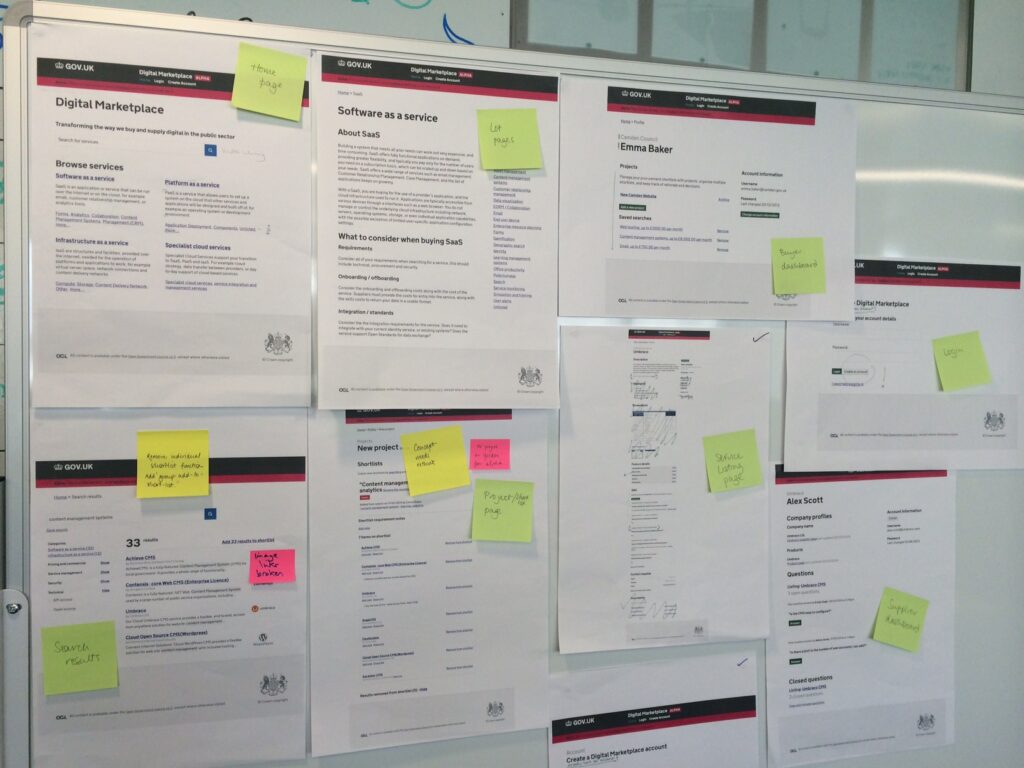At the Government Digital Service, we’ve developed a set of ten design principles which apply to all the work we do here. They inform not only how an individual service ‘looks and feels’, but also the fundamental product design and function. There are four design principles that have particular significance to the Digital Marketplace project.
#1 Start with (user) needs
We have thousands of suppliers who provide services to tens of thousands of public sector buyers through digital procurement frameworks. Over 30,000 different organisations are eligible to buy through G-Cloud alone.
Each one of these buyers, suppliers and individual procurement activities are unique and diverse. That means we need to provide a system with tools flexible enough to meet those different scenarios. At the same time, through our research, we understand that there are ultimately two core needs - buyers want to be able to legally buy the right services at the best price for the taxpayer, and suppliers want the best opportunity to connect with those buyers and present their services clearly and effectively.
Continuing to build up our understanding of how to support these two basic needs for all the different types of buyers and suppliers is at the core of what we are doing as a team.
#4 Do the hard work to make it simple
Government procurement isn’t easy for buyers - it’s traditionally been heavily process and rule-driven, with a lot of complex legal considerations. It’s a far cry from a normal online shopping experience. We know from talking with users that a lot of them are worried about getting things wrong, and getting in trouble.
Supplying to the public sector isn’t easy either - especially for SMEs who only have limited resources. Getting onto procurement frameworks usually involves a lot of confusing paperwork, which can be governed by rules and regulations that are very alien to private business - all without any guarantee of securing any work.
Add to this the fact that we are trying to support a radical transformation in the way the entire public sector procures and manages its digital assets, using a rapidly developing range of technologies, and this becomes very complex, and more than a little daunting.
For us to succeed, we need to do as much of the hard work as possible to remove, simplify, and streamline processes, and at the same time provide a lot of information and support to our users so that they can get their jobs done. As a team, we’re becoming experts in both the technology and procurement processes, so we can make them as simple as possible.
#5 Iterate. Then iterate again
With so many moving parts - processes, people, technology - we can’t, and don’t intend to try, to get everything right the first time. We accept that there are a lot of things we still don’t know, and a lot of different ways to solve a problem or meet a user need; because we are working in an Agile way, we can adapt and explore solutions as we move to our ultimate outcome, connecting buyers and suppliers.
Building an entire marketplace will mean a lot of iterations, adding layers of functionality, built over time and in response to real data and real feedback from users. This means you can expect a lot of requests from us for feedback and volunteers for user research, and also for the Digital Marketplace itself to continue to change rapidly, and substantially, as it evolves.
#10 Make things open: it makes things better
We are aiming to be as open as possible with everything we’re doing - sharing our progress and thoughts regularly via this blog, as well as releasing changes to the product early and often. In the next few weeks we’ll be launching our Alpha publicly, and because we know there is a lot for us still to learn and do, we’re excited about getting your feedback.
This belief and commitment to transparency isn’t just part of the way are we working to develop this product, it is also inherent in the Digital Marketplace itself. Markets work best when there is a free flow of clear and transparent information for everyone to see, so buyers and suppliers have the best knowledge possible. To that end, we are committed to publicly showing as much information about the activities taking place within the marketplace as possible, ensuring the best possible outcome for the entire community - and the taxpayer.
I hope this article helps give you a better understanding of our approach to this work, and the core principles we’re applying to the Digital Marketplace in light of the big ambitions - and big challenges - that we have for the project.

1 comment
Comment by Ian posted on
"Its a far cry from a normal shopping experience"
No. And neither should it be. One is about buying a small consumer item, the other a many thousand pound investment of the nation's money. Dumbing down procurement is a truly dreadful outcome to be aiming for.